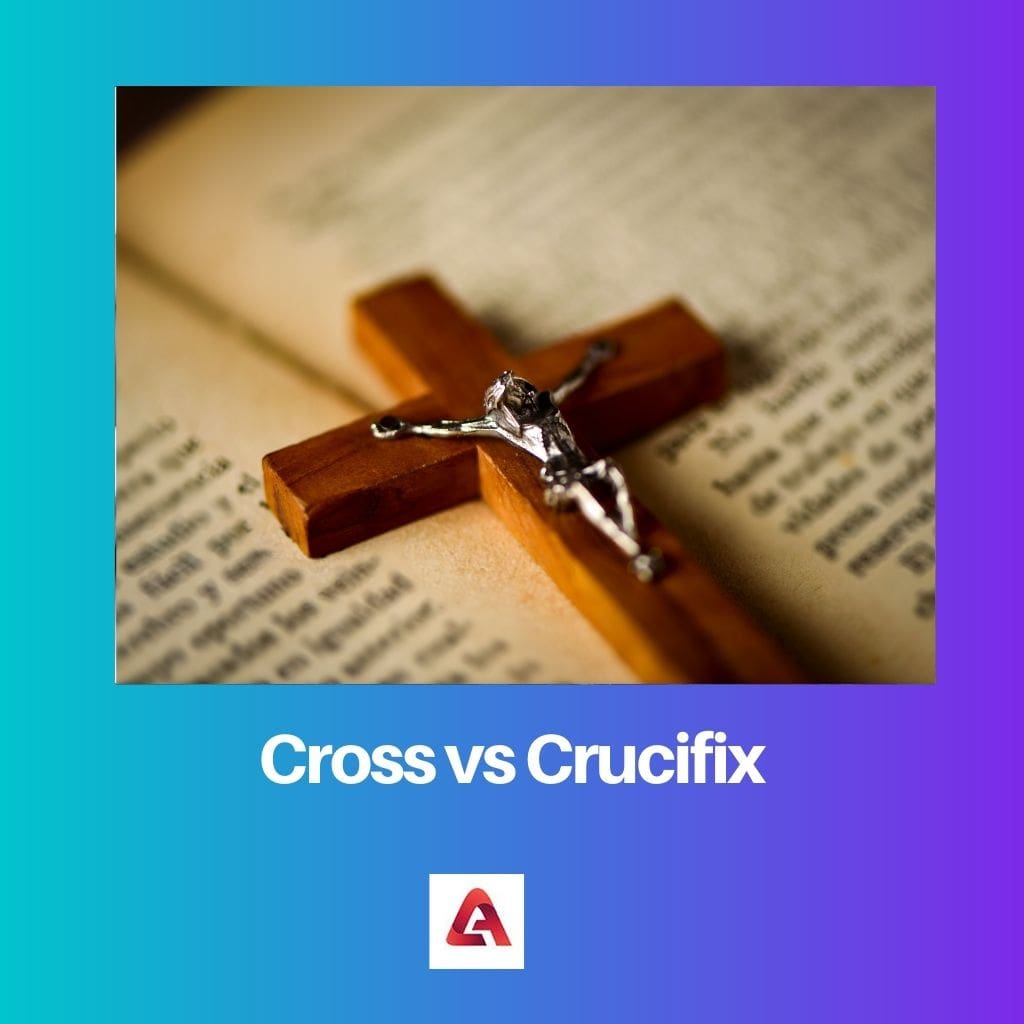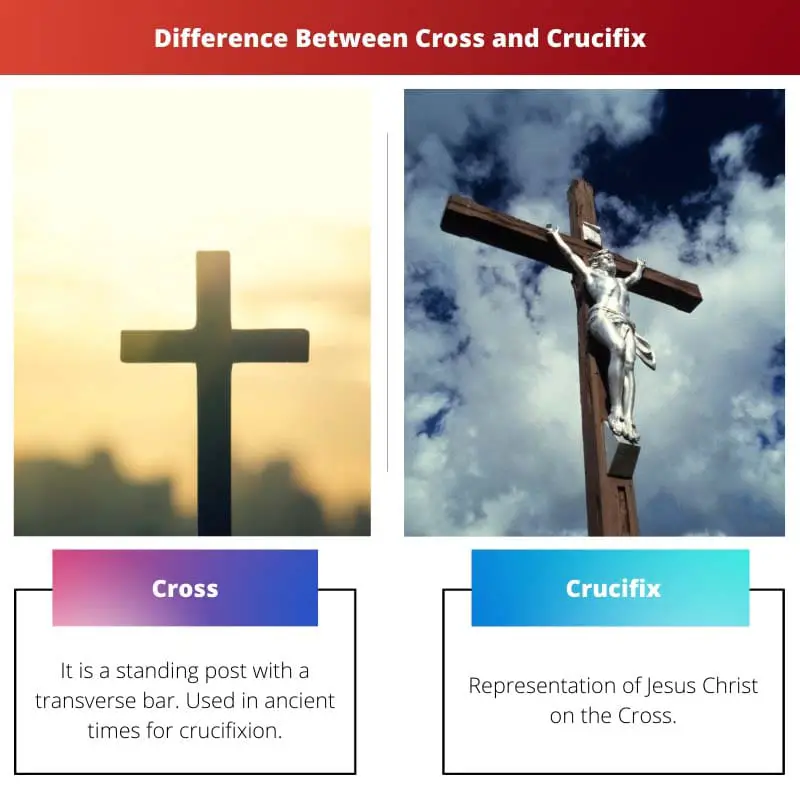A cross is a simple geometric symbol representing Christianity, featuring two intersecting lines. On the other hand, a crucifix is a specific type of cross that includes a depiction of the crucified Jesus Christ, symbolizing the sacrifice and redemption central to Christian theology.
Key Takeaways
- A cross is a symbol with two intersecting lines, representing the instrument of Jesus Christ’s crucifixion. At the same time, a crucifix is a cross with a representation of Jesus’ body (corpus) attached to it.
- The cross is a more abstract and universal symbol used in various religious and cultural contexts, whereas the crucifix is specifically associated with Christianity and the depiction of Jesus’ sacrifice.
- Christian denominations use the symbols differently: the crucifix is more common in Catholic and Orthodox traditions, while the cross is more prevalent in Protestant faiths.
Cross vs Crucifix
The difference between a Cross and Crucifix is that the Cross is a cross-shaped item without a symbol or figure of Jesus, while Crucifix is a Cross with Jesus depicted or engraved on the same.

However, the above is not the only difference. A comparison between both the terms on specific parameters can shed light on subtle aspects:
Comparison Table
| Feature | Cross | Crucifix |
|---|---|---|
| Symbol | A simple two-beam intersecting figure, in the shape of a T or X. | A cross with the figure of Jesus Christ depicted upon it, representing his crucifixion. |
| Meaning | Represents Christianity in general, symbolizing faith, salvation, and sacrifice. | Represents specifically the sacrifice of Jesus Christ on the cross for humanity’s redemption. |
| Emphasis | On the faith and principles of Christianity. | On the suffering and sacrifice of Jesus Christ. |
| Use | Often used in a wider range of contexts, including churches, jewelry, and decorations. | Primarily used in religious contexts, especially for prayer and devotion. |
| Religious Preference | Used by various Christian denominations, including Catholics, Protestants, and Orthodox Christians. | Primarily used by Catholic and Orthodox Christians, with some Protestant denominations preferring the plain cross. |
What is Cross?
Definition of a Cross
A cross is a geometric symbol that consists of two intersecting lines, perpendicular to each other. This symbol has deep historical and cultural significance, particularly within Christianity.
Geometric Characteristics
- The cross consists of a vertical line intersecting a horizontal line at or near the midpoint.
- It can vary in size, shape, and style, but the fundamental structure remains consistent.
- While the equal-armed cross (also known as the Greek cross) is one of the most recognizable forms, other variations exist, such as the Latin cross with a longer vertical line.
Historical Significance
- The cross has been a symbol of diverse meanings throughout history, predating Christianity. It has been associated with fertility, life, the four elements, and various religious beliefs.
- In Christianity, the cross gained prominence as a symbol of salvation and redemption following the crucifixion of Jesus Christ. It represents the central tenets of Christian faith, including sacrifice, love, and forgiveness.
Cultural and Religious Usage
- The cross is widely used in Christian religious rituals, ceremonies, and iconography. It adorns churches, graves, and religious artifacts.
- Beyond Christianity, the cross has been adopted by diverse cultures and religions, sometimes with altered meanings. For example, it’s found in ancient Egyptian hieroglyphs and Hindu symbolism.
- In contemporary secular contexts, the cross is used as a symbol of hope, strength, and solidarity, transcending religious boundaries.

What is Crucifix?
Definition of a Crucifix
A crucifix is a religious symbol that depicts the figure of Jesus Christ crucified on a cross. It holds profound significance in Christianity, particularly within Catholic and Orthodox traditions, serving as a focal point of devotion and contemplation.
Visual Representation
- A crucifix features a representation of Jesus Christ’s body affixed to a cross, with nails piercing his hands and feet.
- The figure of Christ may vary in style and detail, ranging from realistic depictions to more stylized or symbolic representations.
- The cross itself may bear additional elements, such as inscriptions, symbols of the Passion (such as a crown of thorns), or the INRI inscription (Latin for “Jesus of Nazareth, King of the Jews”).
Symbolism and Religious Meaning
- The crucifix symbolizes the central beliefs of Christianity, particularly the crucifixion and subsequent resurrection of Jesus Christ.
- It serves as a powerful reminder of Christ’s sacrifice for humanity’s sins, embodying themes of redemption, forgiveness, and salvation.
- The crucifix is a focal point of prayer, meditation, and contemplation for Christians, inviting believers to reflect on the suffering and love of Christ.
Usage in Worship and Devotion
- Crucifixes hold a central place in Catholic and Orthodox Christian worship, adorning churches, altars, and personal devotional spaces.
- They are used in religious rituals, such as the Stations of the Cross, where believers reflect on Jesus Christ’s journey to the crucifixion.
- Devotional practices, such as praying before a crucifix or wearing crucifix jewelry, are common among Christians seeking spiritual guidance and solace.

Main Differences Between Cross and Crucifix
- Symbolism:
- A cross is a simple geometric shape with two intersecting lines, symbolizing Christianity and the crucifixion but without depicting Jesus.
- A crucifix is a cross that includes a representation of Jesus Christ, in the form of a corpus (body).
- Representation:
- A cross represents the Christian faith and the sacrifice of Jesus Christ.
- A crucifix represents not only the Christian faith but specifically focuses on the crucifixion of Jesus, emphasizing the suffering and sacrifice.
- Iconography:
- The cross is a more neutral symbol, widely used in Christian denominations that may avoid depicting Jesus on the cross.
- The crucifix is a more specific representation, commonly associated with Catholicism and some other denominations that embrace visual depictions of religious figures.
- Denominational Differences:
- The cross is accepted and used across various Christian denominations.
- The crucifix is more commonly associated with Catholicism, Eastern Orthodoxy, and some high-church Protestant traditions.
- Artistic Depiction:
- Crosses can vary in design and style, emphasizing the geometric shape itself.
- Crucifixes include detailed representations of Jesus on the cross, showcasing artistic interpretations of his crucifixion.
- Liturgical Use:
- Crosses are used in various Christian rituals and ceremonies as a symbol of faith.
- Crucifixes may be more prevalent in Catholic liturgy, where the detailed representation of Christ’s sacrifice holds particular significance.
- Cultural Perception:
- Crosses are widely accepted and recognized as a symbol of Christianity, appearing on churches, graves, and religious artifacts.
- The use of crucifixes may be more divisive in certain cultural or religious contexts, as some denominations prefer a plain cross to avoid visual representations of Christ.
- Jewelry and Accessories:
- Crosses are commonly used in jewelry and accessories as a fashion symbol and expression of faith.
- Crucifixes, while also used in jewelry, may be more explicit in their religious symbolism due to the depiction of Christ.




